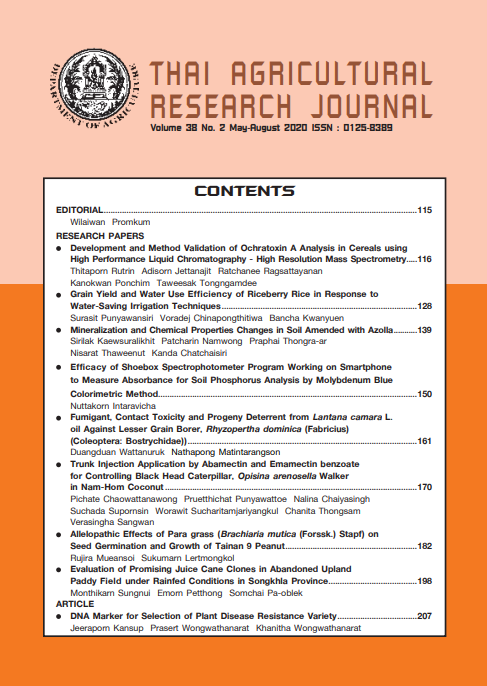Grain Yield and Water Use Efficiency of Riceberry Rice in Response to Water-Saving Irrigation Techniques
DOI:
https://doi.org/10.14456/thaidoa-agres.2020.9Keywords:
Riceberry rice, water management, water use efficiency, water productivity, yieldAbstract
Reducing irrigation water in rice fields while maintaining high grain yield is important for the sustainable rice production. However, water-saving techniques has not been widely adopted by Thai farmers because of constrains in effectiveness and reliability. About 10-20 years ago, the alternate wetting and drying (AWD) technology has been developed and recommended to irrigated rice farmers in Asian countries. But the performance of the AWD technology has not yet been evaluated for water use efficiency for Riceberry rice. The objective of this study was to determine the effects of two AWD treatments (AWD1, AWD2) had on growth grain yield and yield components of Riceberry rice as compared to the conventional farmer’s practice by continuous flooding method (CF). In AWD1, water level was let to drop to -5 cm below ground level, the field was then reflooded until the water level reached 5 cm above ground; in AWD2, water level was maintained at 5 cm above ground from the first day of transplanting until 25 and 45 days after transplanting when water level was let to drop to -15 cm below the ground level and then reflooded the field until the water level reached 5 cm above ground. While in continuous flooding method (CF) the water level was kept at 5 cm above ground for the entire season. The experiments were carried out in the irrigated paddy fields in Chiang Mai provinces in dry seasons of 2016 and 2017. Results revealed that both AWD1 and AWD2 consumed less water than the continuous water supply method, (CF) at approximately 31.75 – 34.06 % in 2016 and about 33.38 – 40.59 % in 2017 with no different in grain yield and ield components. Moreover, both the irrigation water productivity and water use efficiency of AWD method were higher than those of the CF method. In conclusion, the AWD water-saving irrigation techniques are the appropriate water management techniques for cultivation of Riceberry rice and it is an effective way to reduce the amount of water used in the agricultural sector in Thailand.
References
ธวัชชัย ณ นคร. 2526. ความสัมพันธ์ดิน น้ำและพืช. ว.วิชาการเกษตร. ปีที่ 1 กันยายน -ธันวาคม 2526. หน้า 185-195.
พัชรี แสนจันทร์. 2540. เกษตรชลประทาน. ภาควิชาปฐพีศาสตร์ คณะเกษตรศาสตร์ มหาวิทยาลัยขอนแก่น. ขอนแก่น 335 หน้า.
ลัดาวัลย์ กรรณนุช, กิ่งแก้ว คุณเขตุ, นิตยา รื่นสขุ, กษิน ขําเลขะสิงห์, สุรพล จัตุพร, อมรรัตน์ อินทร์มั่น, อัญชลี คร้ามศรี, นิวัติ เจริญศิลป์, วิชัย หิรัญยูปกรณ์, นิกูล รังสิชล และ สุเทพ ลิ้มทองกุล. 2544. การปลูกข้าวนาปรังโดยระบบการใช้น้ำอย่างประหยัด. หน้า 107-119. ใน: รายงานการประชุมวิชาการ ศูนย์วิจัยข้าวปทุมธานี 2544. ศูนย์วิจัยข้าวปทุมธานี สถาบันวิจัยข้าว กรมวิชาการเกษตร กระทรวงเกษตรและสหกรณ์.
วิบูลย์ บุญยธโรกุล. 2526. หลักการชลประทาน. ภาควิชาวิศวกรรมชลประทาน คณะวิศวกรรมศาสตร์ มหาวิทยาลัยเกษตรศาสตร์.
อัจฉรา ชุมวงศ์ และ บัญชา ขวัญยืน. 2551. การจัดการน้ำในนาข้าวเพื่อลดผลกระทบสิ่งแวดล้อมเกี่ยวกับน้ำและบรรยากาศ. วิศวกรรมสารฉบับวิจัยและพัฒนา ปีที่ 19 ฉบับที่ 2 กรกฎาคม-กันยายน 2551. หน้าที่ 52-59.
Barker, R., Tuong, T.P., Li, Y., Castillo, E.G., and Bouman, B.A.M. 2004. Growing More Rice with Less Water Research Findings from a Study in China, Paddy and Water Environment (2:4 ), 2004, 185-192.
Bhuiyan, S. I. 1992. Water Management in Relation to Crop Productivity: Case Study on Rice. Outlook Agriculture (21:4), 293-299.
Biao Zhang, Zetian Fu, Jieqiong Wang and Lingxian Zhang. 2019. Farmers’ adoption of water-saving irrigation technology alleviates water scarcity in metropolis suburbs: A case study of Beijing, China. Agricultural Water Management (212), 349–357.
I.R.R.I. 2009., Saving water alternate wetting and drying (AWD). IRRI Rice Fact Sheet. Los Banos, Philippins: International Rice Research Institute.
Kumar, J., Rani, S., Sohane, R. K., Hasan, W. and Paswan, A. K. 2018., Irrigation Management in Paddy based on Depleting Water Level below Soil Surface, Int. J. Pure App. Biosci. SPI: 6(1): 56-62.
L.C. Guerra, S.I. Bhuiyan, T.P. Tuong, and R. Barker. 1998. Producing more rice with less water from irrigated systems. IRRI Discussion Paper Series. International Rice Research Institute, Philippines. NO. 29
Peng Zhang, Olivier Deschenes, Kyle C. Meng and Junjie Zhang. 2017. Temperature Effects on Productivity and Factor Reallocation: Evidence from a Half Million Chinese Manufacturing Plants. DISCUSSION PAPER SERIES. IZA – Institute of Labor Economics, Germany. IZA DP No. 11132.
Tuong, T.P., and Bouman, B.A.M. 2003. Rice Production in Water-Scarce Environments. Agricultural Water Management. (2), 13-42.
Zhi, M., and Zhifang, X. 1998. Water Saving Irrigation Techniques for Rice, CCTV Press, China.
Downloads
Published
How to Cite
Issue
Section
License
Copyright (c) 2020 Thai Agricultural Research Journal

This work is licensed under a Creative Commons Attribution-NonCommercial-NoDerivatives 4.0 International License.
Thai Agricultural Research Journal



